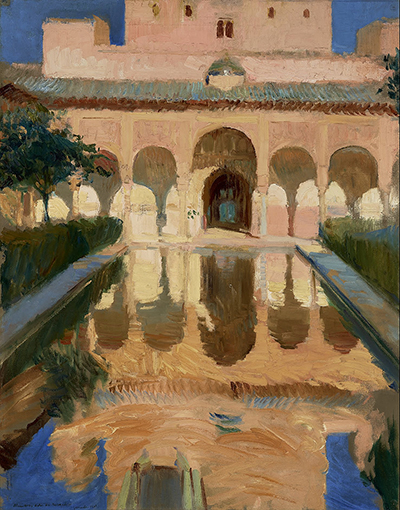The unique atmosphere of the old Moorish palace of the Alhambra in Granada, Spain, is captured in this oil on canvas rendition of the Hall of the Ambassadors, produced in 1909 by Joaquín Sorolla y Bastida.
The artist was always interested in how light behaved as it interacted with its surroundings,, and here, the harsh sunlight is diffused as it dances on the water's surface, in ripples that are reflected on to the amber walls of the Hall of the Ambassadors beyond. An azure sky provides a startling contrast, both above, and in the reflection below. The stunning palace and grounds of the Alhambra, designed with running water, recesses and carved ceilings to maximise shade as protection from the heat of Southern Spain, were erected between 1238 and 1358. It was the last of its kind in Western Europe in the late Middle Ages, and was the ultimate Moorish achievement, a solid building that seems nevertheless to possess a mysterious, ethereal beauty. Joaquín Sorolla has managed to convey this with a lightness of touch, despite his application of thick brush strokes.
The Hall of the Ambassadors itself is the biggest room in the Alhambra, and was once the reception chamber containing the sultan's throne. Granada, which is situated in the foothills of the Sierra Nevada mountains of Andalusia, boasts its own memorable medieval architecture, and Sorolla later captured the city and its environs in a softer impressionistic painting. Born in Valencia in 1863, Joaquín Sorolla y Bastida typically painted landscapes and portraits, or subjects with a social or historical context, such as this one of a past civilisation at the Alhambra. His work portrayed Spain, its people, climate and surroundings with perception, grasping the effects of colours that are unique to the country. He particularly liked to play around with the effects of sunlight on water, sometimes confusing the eye with reflected images, and often working "en plein air".
Naturally, Sorolla looked back to the greats of Spanish art, like Goya and Velázquez. The latter's influence can be seen in the way that he used composition, and in his treatment of light and dark. He was also influenced by the new medium of photography, which inspired him to experiment with unusual angles and cropped compositions. Although Sorolla settled in Madrid, he made regular trips back to Valencia for its strong light and open horizons. He is well-known for his sea paintings, and sometimes worked from a platform to catch the light on the constantly-shifting waves from above. He has remained one of Spain's most popular artists, and delivers a very Spanish take on the impressionist style that still influences painters today.




